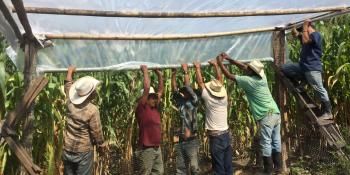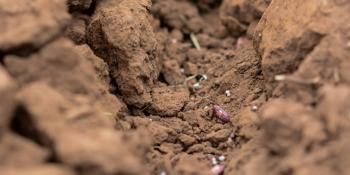As Latin America embraces climate-smart agriculture, negotiators should do the same

The world can learn from innovations in this region.
Climate experts from around the world descend on Lima, Peru this week for international talks focused on an elusive but essential goal: crafting an enforceable agreement by 2015 that will significantly reduce greenhouse gas emissions worldwide and encourage efforts to adapt to the changes in temperature and precipitation already underway.
But amid all of the important dialogue about setting “emission targets,” securing contributions to a “Global Climate Fund,” and establishing “compliance mechanisms,” there is one area that unfortunately will receive far too little attention.
The 20th gathering of the “Conference of the Parties” (COP 20) of the United Nations Framework Convention on Climate Change (UNFCCC) will feature far too few mentions of the word “agriculture.” That’s a major omission, because it’s hard to imagine any sector other than agriculture that figures so prominently as both a cause and a victim of climate change.
From the carbon released when clearing and plowing land for crops, to the nitrous oxide associated with fertilizers, to the methane generated by livestock, agricultural practices currently account for about 19 to 29 percent of global greenhouse gas emissions. Meanwhile, climate change looms as a major threat to agriculture as it alters growing conditions in ways that could dramatically depress food production.
That’s why many of us seeking a higher profile for agriculture in the climate talks feel fortunate that this meeting is occurring in Latin America. Perhaps more than any other region in the world, Latin Americans are embracing a new approach to food production that seeks to simultaneously increase yields, improve farmers' resilience to climate change, and reduce greenhouse gas emissions. It’s called “climate-smart” agriculture.
It’s easy to understand why Latin Americans are concerned about the interaction between agriculture and climate change. In fact, a good example can be found just a short plane ride from the negotiating tables in Lima in Peru’s Sacred Valley of the Incas where rising temperatures are threatening the world’s largest diversity of potatoes.
Meanwhile, farther to the north in Central America, three Latin American countries—Guatemala, Honduras and Costa Rica—have declared national emergencies as climate change accelerates the spread of a fungus known as roya, or coffee rust, that is decimating coffee production. Cocoa and banana production in the region are also grappling with climate-induced threats.
Many countries in Latin America are responding to the challenges with climate-smart initiatives that help farmers adapt to climate change while also mitigating their contribution to the problem.
For example, a new effort is underway to protect potato production and diversity in Peru while also reducing agriculture-related emissions. Among other things it is prompting renewed interest in the ancient terracing systems still used around places like Machu Picchu that allow potatoes and other crops to be cultivated at high altitudes while preventing erosion and boosting soil health.
In Nicaragua, CGIAR’s International Center for Tropical Agriculture (CIAT) has worked with government officials along with private sector interests, producers, and civil society groups to develop a “climate-smart” response to coffee and cocoa production issues. For example, in areas that may soon be too hot to support coffee production, farmers might be able to switch to cocoa production, a “climate smart” alternative to simply shifting coffee to higher elevations where it could threaten fragile forested regions.
In Guatemala, CGIAR’S Research Program on Climate Change, Agriculture and Food Security (CCAFS) is working closely with the Ministry of Agriculture, Livestock and Food in order to prioritize climate smart agriculture practices. The results suggest that investing in agroforestry—where trees are planted to provide agricultural benefits like improved soil health—should be a high priority.
Meanwhile, in Colombia, scientists are working with government officials, producer associations and other research institutes to make “climate-smart” agriculture a pillar of Colombia’s overall national climate strategy. The approach is evident in efforts to help farmers identify when to plant, what to plant and how to plant in an increasingly variable and unpredictable climate.
For example, researchers analyzed decades of data on rice production and climate in Colombia to understand why rice production has been declining. The work uncovered previously unknown linkages between temperatures and rice growth, which allowed the scientists to predict conditions for the 2014 growing season. The Rice Growers Federation (FEDEARROZ) used these observations to make recommendations directly to farmers, preventing massive crop losses. And the research was a winner of the UN Big Data Climate Challenge.
The Ministry is also making efforts to reduce farming’s climate footprint by promoting “silvopastoral” grazing systems, which add trees to the landscape in ways that improve vegetation and reduce soil erosion. These systems contribute 40 percent fewer greenhouse gas emissions compared with traditional pasture grazing.
It would be appropriate, as they gather in a region that keenly understands the climate change-agriculture connection, that climate negotiators finally bring farmers into the fold. They should at least open the door for agriculture to be included in the climate accord expected to be ratified next year at a potentially historic climate summit in Paris. Farmers in Latin America and around the world are embracing the potential of climate-smart agriculture. They are now inviting UN negotiators to do the same.
Originally published in Spanish in Efe Verde: Mientras América Latina adopta la agricultura sostenible adaptada al clima, urge que los negociadores climáticos, en Perú, hagan lo mismo
How do we make sure the next global climate change agreement does not close the door on agriculture? Leave your comments below!
CCAFS and partners will share experiences and insights on agriculture and food security at key events in Lima – if you’re in Lima, please join us, or join the conversation online by following our COP20 blog, @cgiarclimate on twitter, on Facebook and Google+.
Dr. Ana Maria Loboguerrero Rodriguez is the Latin America Regional Program Leader for the CGIAR Research Program on Climate Change, Agriculture and Food Security.



